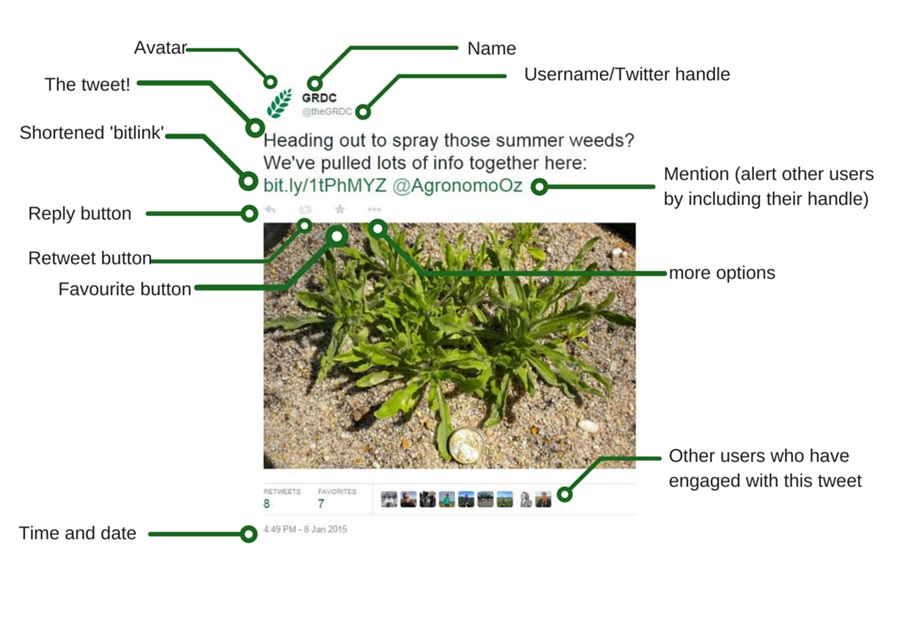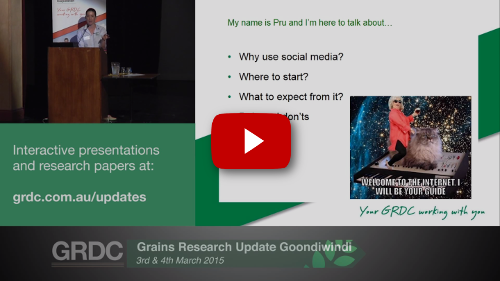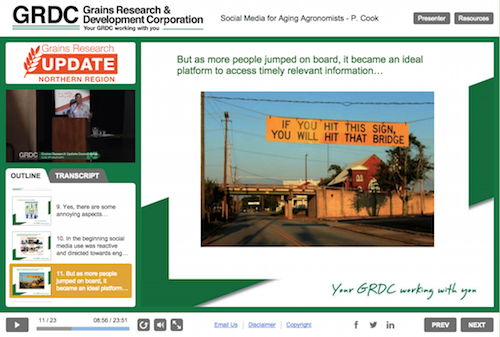Getting the most out of social media: a grains industry perspective
Author: Pru Cook, Grains Research and Development Corporation | Date: 25 Feb 2015
Social media (Twitter in particular) is here to stay and has real benefits for those in the grains industry by allowing real-time information sharing. Outlining what you want to achieve from a social media presence and developing a strategy will help you derive the most value.
Background
Despite the big names in social media platforms being around for well over a decade, for many the mere mention of the term social media brings up images of celebrity gossip, cat pictures, mundane facts about distant relatives eating habits and drunken opinions best kept to one’s self.
While social media may have started out being mainly about the above, it’s also emerged as a serious business tool with many industries using these platforms to not only promote their business but to gain a better understanding of their customers while tapping into larger and more diverse audiences.
Agriculture has seen an explosion in uptake and usage. The past five plus years have seen agricultural use evolve from a platform used by a handful to combat anti-ag activism into a preferred information gathering channel used for everything from troubleshooting machinery problems, to linking up to international researchers, to understanding audience communications preferences.
There are no signs that it’s slowing down despite initial feelings that it’s a fad. Grains industry audiences are growing daily and the wealth of information available, plus filtering and analytics tools are becoming increasingly sophisticated. Users are also hanging around; recent research conducted by Social:Farmer discovered that 87 per cent of farmers who joined Twitter before 2010 were still actively tweeting in 2014!
Four main social media platforms dominate the Australian grains industry at present. They are:
- Twitter – allows you to receive information from other users of your choosing. This information comes in short SMS style messages called ‘Tweets’.
- Facebook – a social networking site that allows longer messages and greater control over who sees your content.
- YouTube – a search engine for videos ranging from professional products to smartphone clips.
- LinkedIn – a virtual resume service which allows networking on a professional level.
There are a number of other platforms (image sharing platforms in particular) that are also in use but in a more limited manner.
This paper will focus on Twitter as it currently has the most relevant content readily available to users in the Australian grains industry – the short nature of tweets makes it a nice complement for autosteer! That said, much of the advice in this paper can be equally applied to other social media platforms.
This paper includes key questions, checklists and draft schedules that can help you start to develop your own social media strategy. I haven’t included a budget as Twitter and most of the other tools mentioned in this paper are free – you only need to factor in your time.
Why use Twitter?
A big mistake for those first wading into the world of social media is not understanding why they’re there in the first place. Social media is highly personalised; you adapt the platforms that you use, who you follow and how you use it depending on what you want to achieve.
Before signing up for an account, think about what you want to get out of a Twitter presence. Some suggestions are below – choose as many options as are relevant or add your own.
- Find timely, relevant information from individuals and organisations in my area of interest. (You may wish to use Twitter solely for this reason and not tweet. No worries! However should you wish, further down the track, to seek help through Twitter, people are more likely to help you out if you’ve been active previously)
- Network with those in my industry locally, nationally and/or globally
- Distribute timely, relevant information to help clients and potential clients make decisions
- Invite feedback on my system/business/research etc.
- Troubleshoot problems I’m having (crop diagnosis, technical issues etc.)
- Promote research/products/services/events etc.
- Build my business and/or personal brand
- Get real time intelligence by monitoring industry conversations
- Other
Once you've decided what you want to get out of Twitter, follow the Twitter FAQ section in the resources section of this paper and choose ‘signing up with Twitter’ to set up your very own account.
Who should you follow on Twitter?
Make a list of key information sources you rely on to do your job. Once you’ve finished, search for them and follow them on Twitter to receive the information they’re putting out. Also follow people who you think would benefit from your content as they may follow you back and it provides you with opportunities to engage with them and answer their questions. Examples of who to follow could include:
- Growers
- Advisers
- Researchers
- Grower Groups
- Seed/chemical/fertiliser/marketing Companies
- Local and agricultural media (newspapers/magazines/radio stations)
- Other
Here are some tips that you may find handy when following people and viewing their tweets:
- To find good people to follow, go to a Twitter profile of someone who you think puts out good information and follow who they’re following.
- Someone tweeting information that’s not relevant anymore? Go to their profile, hit the “Following” button is the top right hand corner and you’ll no longer see their info.
- For more advanced filtering of tweets, use a free social media manager such as Tweetdeck (best for desktop users) or Hootsuite (best for mobile users) to sort information according to users, groups of users (called lists), keywords and hashtags.
- If you follow someone that sends tweets that are really important to you, you can get them sent to your phone as a text message. See ‘enabling mobile notifications’ in the resources section.
Posting your own content
If you’re new to Twitter, spend a month or so watching how Twitter works to get your head around what the terminology means (there’s a glossary in the references section to help you here) and how people engage with one another. When you decide you’d like to start putting out content here are a couple of things to consider:
- Remember (particularly if tweeting as a business/organisation) that engagement on Twitter is two way. Ensure anything you tweet has a value proposition for your followers. People will value genuine interaction over a sales pitch.
- Add photos to catch the eye and boost engagement!
- Add links to your tweet to give more information. Use a URL shortener to turn long URL’s into short ones! I use a site called bit.ly which gives me analytics on when and where the link was clicked. There are several other link shorteners that you may choose to use.
- Handles (usernames) and hashtags (used to categorise a tweet) can be worked into the text of the tweet. If unsure, add handles and hashtags at the end of the tweet.
- Before posting ask yourself: “Will my audience members find this information useful? Can they do something with it that will help them?”
- Feel free to tweet the same information more than once. This increases the likelihood of it being picked up. Change the wording of the tweet each time so as not to be repetitive.
- Don’t forget the ‘social’ part! Many people will tweet about sport/hobbies/interests as well as farming – try to just stick to a few key themes though.
Select the types of content you want to share and include examples:
- Your website
- Your blog/Facebook page/YouTube channel
- Photos and observations in the field
- Interesting resources from other websites
- Other
The anatomy of a tweet
Here’s what a tweet looks like with some of the key parts explained.

Retweeting
Retweeting is a good way to start building followers when you first sign up to Twitter. Essentially, retweeting is the digital equivalent of ‘word of mouth’. If you see a tweet that contains information you think is relevant to your audience, retweeting it pushes that information out to your followers while still acknowledging the original poster. More retweets means further reach of your content.
Here are some tips for retweeting:
- Always read links thoroughly or watch entire video etc. before retweeting.
- Sometimes retweets can be perceived as an endorsement – be mindful of this!
- Try to retweet initial tweet (don’t retweet retweets).
Engaging and dealing with feedback
Once you start posting content and building followers, you may start getting questions or comments. Through your monitoring, you may also see conversations that you want to join in. Here’s some tips on getting involved:
- The agriculture community on Twitter is more than happy to help out newbies – don’t stress if you make some mistakes while learning the ropes.
- Be prepared to be challenged on your point of view, one of the great things about Twitter is it allows you to see multiple points of view.
- Be constructive in your feedback – don’t just criticise, present alternatives.
- Sometimes it can be hard to clearly articulate what you mean in 140 characters. If a tweet could be interpreted in different ways, ask the original poster (OP) to clarify before responding.
- Stop, think, check, send and don’t drink and tweet!
- You don’t need to respond immediately. Getting back to someone in 2-3 hours (during business hours) is reasonable.
- You do not have to respond to every tweet. Sometimes leaving something alone, particularly if the commenter is being aggressive or abusive (trolling), is the best response!
- Be mindful of providing advice on Twitter. Offer to take a conversation offline if unsure.
Time commitment and scheduling
Using Twitter can take as much or as little time as you have available. Here’s a suggested basic weekly schedule that will allow you to maintain your account without spending all your time on it! Feel free to adapt to suit your objectives.
- Monitoring: x4 five minute sessions (write down four suitable times and set reminders in your phone)
- Posting: three original and timely tweets per week
- Retweets and favourites: one per day (identified through monitoring activities)
- Responding and engaging where necessary
Success
If you’re using Twitter from an organisational perspective, set some targets to help monitor the effectiveness of your account to ensure you’re meeting the objectives you outlined in the first checklist in this paper.
These targets will depend on what your account is trying to achieve, but could include:
- Number (and type) of followers
- Number of engagements
- Number of clicks on links
- Number of issues resolved
- Number of new clients/sales/event attendees etc. as a consequence of Tweets
- Examples of feedback and/or intelligence to help improve your business
- Increase in website traffic (compare before and after Twitter using Google Analytics)
The resources section includes a list of tools (both free and paid) that can assist with analysing your Twitter account.
Resources
The value and use of social media as a communication tool in the plant sciences
QLD farmers surviving the dry – using social media to connect
Enabling Twitter mobile notifications: https://support.twitter.com/articles/20169887-enabling-mobile-notifications
Social media analytics tools: http://www.socialmediatoday.com/content/50-top-tools-social-media-monitoring-analytics-and-management
Social Media Manual for Groups (Compiled by Landcare with info on Facebook, Twitter and YouTube): http://www.landcareonline.com.au/?page_id=11354
Contact details
Pru Cook
Grains Research and Development Corporation
Level 4 East Building, 4 National Circuit, Barton ACT 2600
Ph: (02) 6166 4500
Email: prudence.cook@grdc.com.au
Was this page helpful?
YOUR FEEDBACK


